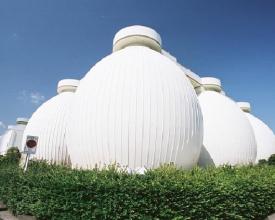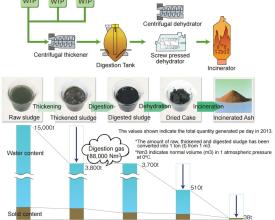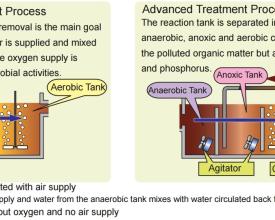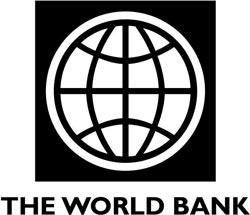
Sustainable Sewage Management
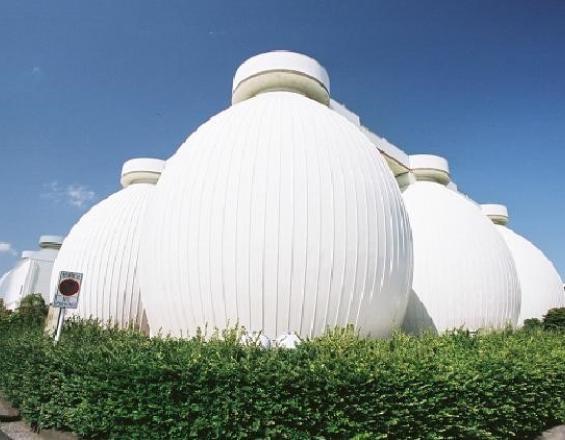
The sewage system of Yokohama City almost fully covers its large territory with more than 3.5 million population. The length of sewer pipes is about 11,000 km in total, equivalent to the distance between Yokohama City and New York City, USA. The city’s 11 wastewater treatment plants constructed between 1962 and 1984 daily treat about 1,500,000 m3 of waste water. The sewage system has been addressing sustainability challenges in resource efficiency, reduction of greenhouse gas (GHG) emissions, and reduction of flood risk in the context of an aging society and national resilience. It also adopted advanced treatment technologies in pursuit of improved sanitary conditions and water quality in rivers and streams.
Context
Challenges addressed
The sewage system faces several sustainability challenges in terms of its service. Firstly, the city is expected to update a large portion of its sewage infrastructure systems within the next 30 years as most of them were constructed more than 20 years ago. Aging sewage pipes and infrastructure not only directly affect the quality of sewage service but they also expose daily life and socio-economic activities in the city to danger, such as sink holes in roads due to damage to pipes, that need to be prevented. Secondly, the City pursuits environmentally sustainable sewage system. For instance, despite of the system thoroughly covering the city area, eutrophication in enclosed water bodies still remained. Moreover, the large amount of sludge generated everyday in the treatment plants reaches about 20% of total industrial waste.
Location
Process
Summary of the process
Sustainable finance is among the biggest challenges the sewage system faces in the context of an aging society. To reduce the total cost, a set of facilities needs to be managed in a systematic manner. Not only does recycling water and processed sludge contributes to environmental conservation, it also helps to recover the costs of maintenance and renewal in sewage system. Application of advanced technologies also enhances quality of treated water, as well as resource recovery and electric power generation.
Building Blocks
Financial Schemes for Sustainable Sewage Management
To cope with the aging sewage systems, a renewal plan has systematically been developed and executed in full consideration of the budget plan. The area where a sewage system was constructed before World War II was designated as the first phase renewal area, followed by a second phase renewal area where a sewage system was constructed from 1945 to 1970. To secure the budget for renewal of sewage infrastructure and continue to provide sound services, it was necessary to improve financial conditions. For example, a target was set to reduce the dependency rate on corporate bond to improve the financial basis for the sewage services. In addition, PFI was introduced to reduce the cost of recycling sludge. Daily management of systems has been strengthened to prolong the life of facilities and pipes, and a database of data and information on the sewage systems is being developed.
Enabling factors
- Systematic plans to renew deteriorating infrastructure facilities
- Financial mechanism for resource recovery
- Developing a database of data and information on the sewage systems
Lesson learned
Sustainable finance is among the biggest challenges the sewage system faces in the context of an aging society. Monitoring and maintaining facilities on a regular basis prolong the life of sewage facilities. This eventually reduces the total life cycle cost of the system in the long run. Furthermore, financial schemes by resource recovery and public-private cooperation help to recover the investment and management cost.
Utilization of Reclaimed Water
Treated wastewater is utilized for various purposes in the city. Three wastewater treatment plants ozonize treated water while all the plants have facilities to filter wastewater by sand. Ozonized water is utilized for toilets, small artificial streams, and air conditioning systems (AC). Sand filtered water is reclaimed for cleaning the wastewater treatment plants and toilets. The treated wastewater generates revenue by being sold to clean drainage pipes and construction plants. Water quality of the reclaimed water complies with standards designated for different usage by the national government.
Enabling factors
- Technologies to clean wastewater and utilize it into various purposes
- Mature markets for reclaimed water
Lesson learned
As water becomes an increasingly a precious resource, reclaimed water also becomes more valuable. Once it is treated by means of the appropriate measures, recycled wastewater can be a useful resource in various occasions. Moreover, revenues generated by selling recycled water to private operators can be allotted for reinvestment to enhance or rehabilitate treatment plants and sewage facilities for sustainable management.
Utilization of Resources Generated from Sludge Treatment
Sludge generated from wastewater treatment process is also recycled in Yokohama City. Sludge generated in eleven wastewater treatment plants is transported to two sludge treatment plants, and then subject to thickening, digestion, and dehydration processes. After the treatment, the weight of the sludge decreases by 400 times, and becomes an odorless, hygienic product. Gas generated during the digestion process is recovered as a source of energy and utilized for electricity generation and fuel for incineration in the treatment plants. In addition, the ash after incineration has been used as raw material for improved soil and cement.
Enabling factors
- Technologies to utilize processed sludge
Lesson learned
No small amount of sludge is generated from wastewater treatment plants, reaching about 20 % of the total industrial waste in Japan. Conventional landfilling of this by-product has been causing lack of space in disposal sites and environmental pollution. Local governments and sewage management bodies may decrease the significant volume of final disposal by cautiously processing the sludge and recycling it to fertilizer for farm land, construction materials, and a source of energy.
Advanced Treatment Process for Further Improvement of Water Quality
The sewage system has been contributing to the improvement of public water quality. The sewage coverage rate increased from 85% in 1989 to 99.8% in 2013. No untreated wastewater flows into rivers, and river water quality has significantly improved. BOD values in major rivers in the city decreased 40 – 87% in 2013 from those in 1984. On the other hand, eutrophication in enclosed water bodies such as lakes and coastal waters still remains. To cope with this issue, Yokohama City introduced advanced treatment technology to remove nitrate and phosphorus contributing to eutrophication. The number of treatment plants applies advanced treatment process increased from two in 1996 to eight in 2013. As the result, the removal rate of nitrogen and phosphorus increased.
Enabling factors
- Advanced treatment technology to remove nitrogen and phosphorus from wastewater
Lesson learned
Wastewater treatment plants do not eliminate harmful substances entirely from wastewater. Remnants of nitrate and phosphorus in treated water contribute to eutrophication especially when they are discharged into closed water bodies. To preserve rich water environment, all the wastewater needs to be treated by collective or individual means before being discharged to water bodies. Moreover, application of effective technologies and continuous monitoring are essential to enhance water quality.
Impacts
Economic Impact: The city is trying to reduce the heavy dependence on corporate bonds, and a new target set for the current mid-term plan aims for further improvement of the city's financial situation of sewage management, such as resource recovery measures to reduce the cost of treatment and increase revenue by the sale of recycle materials, private sector involvement in sewage management for cost reduction, and exporting experience and technology of Yokohama’s sewage system (eg. waste water treatment technology to Batam City in Indonesia under a project by the Japan International Cooperation Agency).
Social Impact: The sewage system in Yokohama contributes to the improvement of sanitation in the city. In addition, small streams where ozonized reclaimed water is used provide excellent waterfront and leisure space for citizens. The efforts to pursue sustainability for sewage systems contributes to serve as inundation mitigation during floods.
Environmental Impact: Water quality in rivers, streams and coastal waters in Yokohama has improved due to its sewage system. Improved water quality also resulted in the increase of diversity of fish in the main rivers. Studies showed that fishes such as killifish, salmon and freshwater minnows returned. About 20% of GHG emissions from business and services operated by the City of Yokohama comes from sewage management.
Beneficiaries
- Residents of Yokohama City
- Private companies in Yokohama City
